20th Anniversary Expansion
 |
You are reading the rules for this tile design. |
| If your tiles have a different design, then choose a game from Spin-offs. |  |
This is a celebratory expansion that serves as a homage to the first 3 major expansions. It does not matter if you don't know them, the gameplay with this mini-expansion is not affected.
General info and comments

The 20th Anniversary was released for the New Edition by Hans im Glück in 2021 as part of the 20th Anniversary Edition.
This expansion has cities cluttered with buildings.
| Changes to the 20th Anniversary Edition
The rules for the 20th Anniversary Edition stay the same but the roles of some meeples have been updated:
Publishers have followed the new roles provided in the rules by HiG, although some of these changes are not noticeable in other languages. Note: We stick to the classic role convension for the sake of consistency with all the exisiting rules for the time being. HiG may decide to update the rules in the future to follow this new naming convention for new releases and reprints. |
Contents
- 15 new land tiles marked with a "20" symbol. These new tiles are divided into 3 groups of 5. Each group has one of the following symbols.
Rules
Preparation
Shuffle the 15 new tiles with the rest of the land tiles.
Gameplay
1. Placing a tile
When you draw a 20th Anniversary Expansion land tile, you place it according to the normal rules. Depending on the direction the arrow symbol arrow is pointing, the following situations may occur:
- If you place a tile with an arrow symbol so that the arrow doesn't point to an adjacent tile, you receive 2 points and your turn continues as usual.
- If you place a tile with an arrow symbol so that the arrow points to an adjacent tile, you activate the arrow symbol and the appropriate action can be performed according to its type (see 2. Placing a meeple and 4. Extra turn action).
- If you place any tile (no arrow symbol required) adjacent to a tile with an arrow symbol so that the arrow points to the tile just placed, you activate the arrow symbol and the appropriate action can be performed according to its type (see 2. Placing a meeple and 4. Extra turn action).
2. Placing a meeple
You may place a meeple on the tile just placed according to the normal rules. However, if you activated an arrow symbol, you may have an additional option depending on the symbol type:
Note: You may not use this action to add a third meeple to the two already placed side by side.
3. Scoring a feature
If you complete a feature with 20th Anniversary Expansion tiles, it is scored according to the normal rules.
Final Scoring
At the end of the game, a feature with 20th Anniversary Expansion tiles is scored according to the normal rules.
4. Extra turn action
Summary
- If you place a tile with an arrow symbol so that the symbol is not activated (the arrow is not pointing to an adjacent tile), you get 2 points immediately, otherwise nothing changes.
- You activate an arrow symbol by placing the tile with the arrow pointing to an adjacent tile, or by placing a tile adjacent to another tile in the playing area featuring an arrow symbol pointing to the tile just placed.
- A maximum of 1 symbol can be activated per turn. If you could activate more than one, you may only choose one of them.
- If you place a symbol tile activating a symbol on another tile in the playing area, you score the usual 2 points (because you do not activate the symbol on the tile just placed).
Other expansions
This section contains additional information about the interactions with other Carcassonne expansions.
![]() Monasteries in Germany /
Monasteries in Germany / ![]() Monasteries in the Netherlands & Belgium /
Monasteries in the Netherlands & Belgium / ![]() Japanese Buildings
Japanese Buildings
Tile distribution
Footnotes
For Icons explanation and licensing please visit Icons page.
- ↑
 The ZMG rules include an additional clarification for monasteries and gardens:
The ZMG rules include an additional clarification for monasteries and gardens:
"You may place a normal meeple (or abbot) on unoccupied monasteries (or gardens) which have been not yet surrounded by 8 tiles." - ↑
 The ZMG rules use a different wording for this sentence and seems mistranslated, since fields are always considered as uncompleted, no matter they are completely surrounded:
The ZMG rules use a different wording for this sentence and seems mistranslated, since fields are always considered as uncompleted, no matter they are completely surrounded:
"Fields which are not completely surrounded count as not yet completed, since they are not scored until the end of the game." - ↑
 This last sentence was included in the rules by Mindok.
This last sentence was included in the rules by Mindok.
- ↑
 This expansion does only allow you to place more than two meeples together this way. Other expansions, such as
This expansion does only allow you to place more than two meeples together this way. Other expansions, such as  Mini #1 - The Flying Machines or
Mini #1 - The Flying Machines or  Mini #7 - The Crop Circles, do not have this limitation.
Mini #7 - The Crop Circles, do not have this limitation.
- ↑
 You may perform only one extra full turn with this symbol.
You may perform only one extra full turn with this symbol.
- ↑
 The idea of this action is to pay homage to the large meeples in Exp. 1, so the new meeple is added to the feature in order to increase your majority vote for the same scoring. So you should be allowed to add a second meeple placed as a monk if the first one was placed as a monk, or a second meeple placed as an abbot if the first one was placed as an abbot. Mixing meeple positions should not be allowed since they would participate in different scorings and this would defeat the original purpose.
The idea of this action is to pay homage to the large meeples in Exp. 1, so the new meeple is added to the feature in order to increase your majority vote for the same scoring. So you should be allowed to add a second meeple placed as a monk if the first one was placed as a monk, or a second meeple placed as an abbot if the first one was placed as an abbot. Mixing meeple positions should not be allowed since they would participate in different scorings and this would defeat the original purpose.
- ↑
 If the special monastery is completed, you should not be allowed to place a meeple as a monk on it since the same restrictions as for magic portals should apply.
If the special monastery is completed, you should not be allowed to place a meeple as a monk on it since the same restrictions as for magic portals should apply.









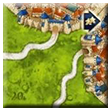

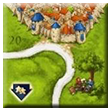
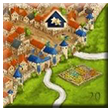
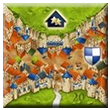

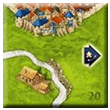
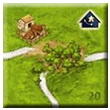
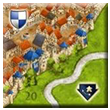
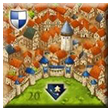
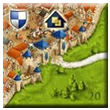
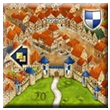


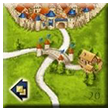





Hello! We played for the first time with the 20th anniversary edition! I've been searching for an answer to scoring the abbot. When retrieving and scoring an abbott on an incomplete monastery scoring with 8 points, the next time I place a tile with the feature of adding an extra meeple, can I put the abbot back on the incomplete monastery?
When you add a meeple to a special monastery using crop circles do you have to take the same position as your previous meeple? I assume yes since it works this way with 20th anniversary expansion.
20th Anniversary Expansion: This is not clearly stated at Monasteries.
Is it possible to obtain higher quality images?
The "Add a meeple" symbol can be used to add an acrobat?
1. If a feature is already shared by two or more players by connecting, is it still possible to add second meeple with the special arrow symbol? Or do I need to do it when I am still sole owner of the feature?
2. Is the activation of new symbols optional? If you place a tile with an arrow symbol so that the arrow points to another tile can I choose not to activate the effect on the arrow and take 2 points instead?
I guess there will be no clarifications about this, but...
How does builder, 20 anniversary extra turn and message turn interact (not to mention the Saint Nicholas scoreboard) ?
If I get: - During my first turn, 20 anniversary symbol activated, new tile message and extend a feature with my builder - During message turn, new 20 anniversary symbol activated (or is this also restricted?) and extend a feature with my builder - During 1st builder turn, new 20 anniversary symbol activated (or is this also restricted?) (builder turn can not be granted during builder turn) - 2nd builder turn, let's say nothing's activated there - And then, 3 20 anniversary extra turn are granted ? If, during those turns, there's new builder and/or message turns granted, can I activate a new 20 anniversary extra turn symbol during those builder and messages extra turns?
Well... The easiest would be to state that only one turn of each type may be granted, no matter what, before passing on to the next player !
Corinthiens.13
Can we place any type of meeple next to any type of already placed meeple (as long as they're compatible) ?
Example, can I place a mayor next to a big meeple on an incomplete city? Or an abbot next to a wagon on a monastery ?
Thanks for your work creating this page !
Corinthiens.13
"If you place a tile with an arrow symbol so that the arrow doesn't point to another tile"...
"If you place a tile with an arrow symbol so that the arrow points to another tile"...
"If you place an ordinary tile (no arrow symbol) next to a tile with an arrow symbol so that the arrow points to it"...
An arrow can point a tile if there are empty spaces between the direction of the arrow and that tile?